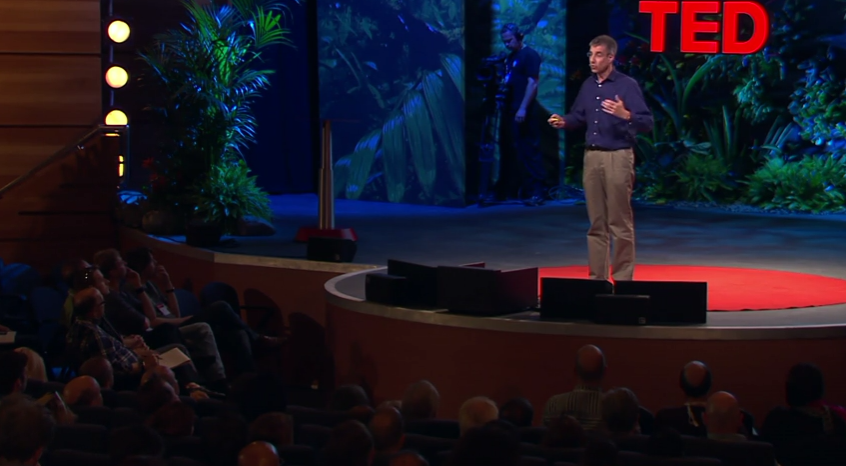But let me show you cutting-edge robotics.
現(xiàn)在我來介紹一下最高端的機(jī)器人技術(shù)。
Now a lot of robotics is very impressive, but manipulation robotics is really just in the dark ages.
如今許多項(xiàng)機(jī)器人技術(shù)已經(jīng)相當(dāng)厲害,可是在機(jī)器人動(dòng)作控制方面我們遇到了瓶頸,看不到曙光。
So this is the end of a Ph.D. project from one of the best robotics institutes.
這是在一個(gè)頂尖機(jī)器人控制學(xué)院里,一個(gè)博士研究項(xiàng)目的成果。
And the student has trained this robot to pour this water into a glass.
這位博士生訓(xùn)練這個(gè)機(jī)器人向這個(gè)玻璃杯里面倒水。
It's a hard problem because the water sloshes about, but it can do it.
這很難實(shí)現(xiàn),因?yàn)樗畷?huì)灑出來,不過機(jī)器人能做到。
But it doesn't do it with anything like the agility of a human.
但是機(jī)器人無法達(dá)到任何接近于人類的靈活程度。
Now if you want this robot to do a different task, that's another three-year Ph.D. program.
并且如果想讓機(jī)器人完成另一個(gè)任務(wù)的話,就得要另外一個(gè)歷時(shí)三年的博士項(xiàng)目了。

There is no generalization at all from one task to another in robotics.
在機(jī)器人控制領(lǐng)域,從一項(xiàng)任務(wù)到另一項(xiàng)任務(wù),根本沒有共通性可言。
Now we can compare this to cutting-edge human performance.
現(xiàn)在我們?cè)賮砼c最尖端的人類性能做比較。
So what I'm going to show you is Emily Fox winning the world record for cup stacking.
我會(huì)播放艾米莉·福克斯疊杯子獲得世界記錄的場(chǎng)景。
Now the Americans in the audience will know all about cup stacking.
觀眾里有美國(guó)人的話一定知道疊杯子這個(gè)游戲。
It's a high school sport where you have 12 cups you have to stack and unstack against the clock in a prescribed order.
這是個(gè)高中里的娛樂項(xiàng)目,要求把12只杯子按照一定順序以最快速度摞起來再展開回來。
And this is her getting the world record in real time.
下面就是她創(chuàng)下世界記錄的實(shí)時(shí)情況。
And she's pretty happy. We have no idea what is going on inside her brain when she does that, and that's what we'd like to know.
看她多開心。我們不清楚她疊杯子的時(shí)候大腦里發(fā)生了什么,而且我們的確很想知道。
So in my group, what we try to do is reverse engineer how humans control movement.
所以我和我的團(tuán)隊(duì),試圖去逆向?qū)崿F(xiàn)人類如何控制動(dòng)作的過程。
And it sounds like an easy problem.
看起來問題很簡(jiǎn)單。
You send a command down, it causes muscles to contract.
你送出一個(gè)指令,令肌肉收縮。
Your arm or body moves, and you get sensory feedback from vision, from skin, from muscles and so on.
這樣手臂或軀干就會(huì)運(yùn)動(dòng),然后能夠獲得從視覺、皮膚和肌肉和其他地方獲得感官回饋。
The trouble is these signals are not the beautiful signals you want them to be.
但問題是這些信號(hào)遠(yuǎn)沒有想象中的那樣完美。
So one thing that makes controlling movement difficult is, for example, sensory feedback is extremely noisy.
比如說,其中的難點(diǎn)之一就是感官回饋中的雜音非常大。
Now by noise, I do not mean sound.
我這里所說的“雜音”不是指聲音。
We use it in the engineering and neuroscience sense meaning a random noise corrupting a signal.
在工程學(xué)和神經(jīng)學(xué)里面,我們用“雜音”來表示干擾正常信號(hào)的隨機(jī)雜亂信號(hào)。
So the old days before digital radio when you were tuning in your radio and you heard "crrcckkk" on the station you wanted to hear, that was the noise.
所以以前還沒有電子收音機(jī)的時(shí)候,如果調(diào)那種老式收音機(jī),電臺(tái)里面有時(shí)候有“喀喇喀喇”的聲音,那個(gè)就是雜音。
But more generally, this noise is something that corrupts the signal.
推廣來說,雜音就是相對(duì)于正常信號(hào)的干擾信號(hào)。



